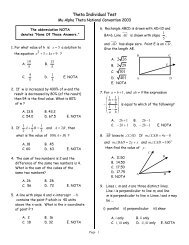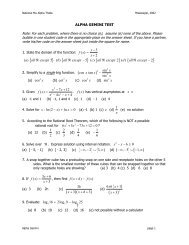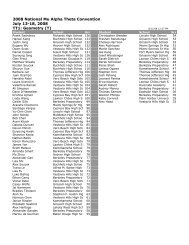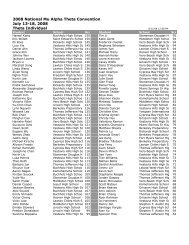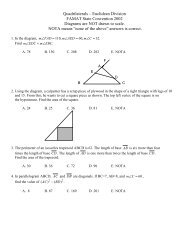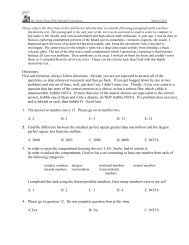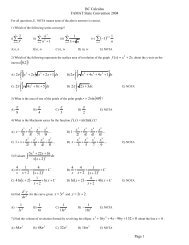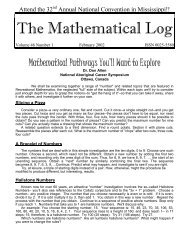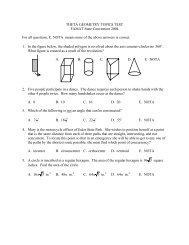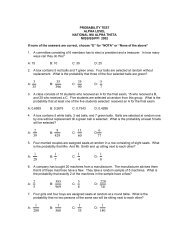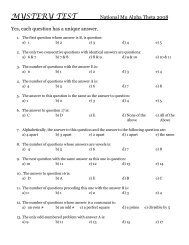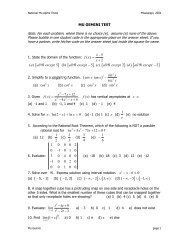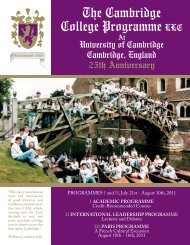2004 National Mu Alpha Theta Convention Mu DivisionâNumber ...
2004 National Mu Alpha Theta Convention Mu DivisionâNumber ...
2004 National Mu Alpha Theta Convention Mu DivisionâNumber ...
You also want an ePaper? Increase the reach of your titles
YUMPU automatically turns print PDFs into web optimized ePapers that Google loves.
<strong>2004</strong> <strong>National</strong> <strong>Mu</strong> <strong>Alpha</strong> <strong>Theta</strong> <strong>Convention</strong><br />
<strong>Mu</strong> Division–Number Theory Topic Test<br />
1. What is the least common multiple of 72 and 30?<br />
A. 180 B. 360 C. 540 D. 720 E. NOTA<br />
2. What is the smallest positive integer with three different prime factors?<br />
A. 8 B. 30 C. 60 D. 72 E. NOTA<br />
3. Zero is not a positive number. If it were considered to be positive, which of the following<br />
statements would no longer be considered true:<br />
I. A negative number times a positive number is always negative<br />
II. A positive number plus a positive number is always positive<br />
III. A positive number times a positive number is always positive<br />
IV. A negative number times a negative number is always positive<br />
A. I only B. II only C. I and III D. IV only E. NOTA<br />
4. Find the sum of all values of A such that the three digit number 6A4 is divisible by 3.<br />
A. 7 B. 10 C. 12 D. 15 E. NOTA<br />
5. What is the largest prime factor of 100! ?<br />
A. 91 B. 97 C. 10001 D. Cannot be determined E. NOTA<br />
6. What is the smallest integer n such that the sum of the first n positive integers is divisible<br />
by 13?<br />
A. 11 B. 12 C. 13 D. 14 E. NOTA<br />
7. When k is divided by 7, the result has a remainder of 3. When j is divided by 3, the result<br />
has remainder 1. What is the remainder when k + j is divided by 21?<br />
A. 4 B. 10 C. 17 D. Cannot be determined. E. NOTA<br />
8. For how many positive integers n less than 1000 is n! + 1 divisible by n?<br />
A. 0 B. 1 C. 333 D. 999 E. NOTA
<strong>2004</strong> <strong>National</strong> <strong>Mu</strong> <strong>Alpha</strong> <strong>Theta</strong> <strong>Convention</strong><br />
<strong>Mu</strong> Division–Number Theory Topic Test<br />
9. How many integers have 7 digits when written in binary (leading zeroes are not considered<br />
digits, so 0011000 is not a 7-digit binary number)?<br />
A. 64 B. 128 C. 256 D. 512 E. NOTA<br />
10. I write the integers from 2 to 400 on a piece of paper. I then circle all the primes. Then I<br />
circle all the previously uncircled numbers which are multiples of 2, 3, 5, or 7. How many numbers<br />
have no circle?<br />
A. 12 B. 16 C. 19 D. 20 E. NOTA<br />
11. Which of the following is the list of possible units digit of a perfect square that ends with<br />
4 identical digits?<br />
A. 0 only B. 0 or 4 only C. 0, 1, or 4 only D. 0, 1, 4, or 6 only E. NOTA<br />
12. Given that p, q, and r are primes with p < q and p + q = r, find p.<br />
A. 2 B. 3 C. 13 D. Cannot be determined E. NOTA<br />
13. What is the largest integer which must divide the sum of the two digit numbers AB and<br />
BA for values of the digits A and B?<br />
A. 1 B. 3 C. 7 D. 11 E. NOTA<br />
14. Two numbers are called relatively prime if their greatest common divisor is 1. How many<br />
numbers less than 120 are relatively prime to 120?<br />
A. 32 B. 36 C. 40 D. 48 E. NOTA<br />
15. Find the largest integer that evenly divides n 5 − 5n 3 + 4n for all integers n.<br />
A. 24 B. 60 C. 120 D. 240 E. NOTA<br />
16. Let n be a randomly chosen two-digit positive integer. What is the probability that the<br />
fraction 6/n is reducible?<br />
A. 1/2 B. 2/3 C. 4/5 D. 5/6 E. NOTA
<strong>2004</strong> <strong>National</strong> <strong>Mu</strong> <strong>Alpha</strong> <strong>Theta</strong> <strong>Convention</strong><br />
<strong>Mu</strong> Division–Number Theory Topic Test<br />
17. How many distinct integer solutions (x, y) are there to x 2 − y 2 = 105?<br />
A. 2 B. 4 C. 8 D. 16 E. NOTA<br />
18. What is the largest value of k such that every integer divisible by 20, 24, and 36 is divisible<br />
by k?<br />
A. 180 B. 360 C. 4320 D. 17280 E. NOTA<br />
19. How many perfect squares less than 500 are divisible by at least 4 distinct positive numbers?<br />
A. 9 B. 13 C. 14 D. 22 E. NOTA<br />
20. If m is divisible by 420 and n is divisible by 294, then what is the largest integer which<br />
divides m + n for all values of m and n?<br />
A. 6 B. 7 C. 14 D. 42 E. NOTA<br />
21. The numbers a, b, and c are positive integers. ab is divisible by 32, bc is divisible by 42,<br />
and ac is divisible by 35. What is the largest integer which must divide abc?<br />
A. 56 B. 112 C. 840 D. 1680 E. NOTA<br />
22. A, B, and C are nonnegative integers less than 10. 100A + 10B + C is divisible by 5.<br />
10A + C is divisible by 3. 10B + C is divisible by 4. 10A + B is divisible by 9. Find A + B + C.<br />
A. 3 B. 9 C. 12 D. Cannot be determined E. NOTA<br />
23. How many positive numbers less than 729 have a base 3 representation with no 2’s?<br />
A. 63 B. 81 C. 100 D. 144 E. NOTA<br />
24. For how many positive integers k is 720 the least common multiple of 180 and k?<br />
A. 6 B. 8 C. 12 D. 18 E. NOTA
<strong>2004</strong> <strong>National</strong> <strong>Mu</strong> <strong>Alpha</strong> <strong>Theta</strong> <strong>Convention</strong><br />
<strong>Mu</strong> Division–Number Theory Topic Test<br />
25. Find the maximum possible value of x + y if<br />
and x and y are both integers.<br />
1<br />
x + 1 y = 1 10 ,<br />
A. 10 B. 121 C. 144 D. 132 E. NOTA<br />
26. For how many positive integers k less than 100 is the statement ‘2 a − 2 b is divisible by k<br />
for some integer values of a and b’ true?<br />
A. 0 B. 4 C. 7 D. 99 E. NOTA<br />
27. How many solutions in positive integers (m, n) are there to the equation 3m 2 + 6n = 2003?<br />
A. 0 B. 3 C. 7 D. 9 E. NOTA<br />
28. The number j 2 , where j is an integer, leaves a remainder of k when divided by n (k < n).<br />
How many possible pairs of values (k, n) are there with 1 < n < 10.<br />
A. 22 B. 23 C. 24 D. 26 E. NOTA<br />
29. We define the set of cycles of an integer to be all the integers that are formed by successively<br />
moving the units digit to the front and moving all the other digits over one place to the right. For<br />
example, the set of cycles of 4275 is {5427, 7542, 2754, 4275} and the set of cycles of 51904 is<br />
{45190, 04519, 90451, 19045, 51904}. (Note the treatment of the 0 - it doesn’t disappear as we form<br />
our cycles!)<br />
How many positive 10-digit integers n (i.e. 10 10 > n ≥ 10 9 ) have the property that all members<br />
of the set of cycles of n are divisible by 11111?<br />
A. 900009 B. 810009 C. 1110000 D. 0 E. NOTA<br />
30. Given f(1) = 1, f(2n) = f(n) and f(2n + 1) = f(2n) + 1 for all integers n, for how many<br />
values of n is f(n) = 10 for n < 2003?<br />
A. 2 B. 5 C. 6 D. 9 E. NOTA



